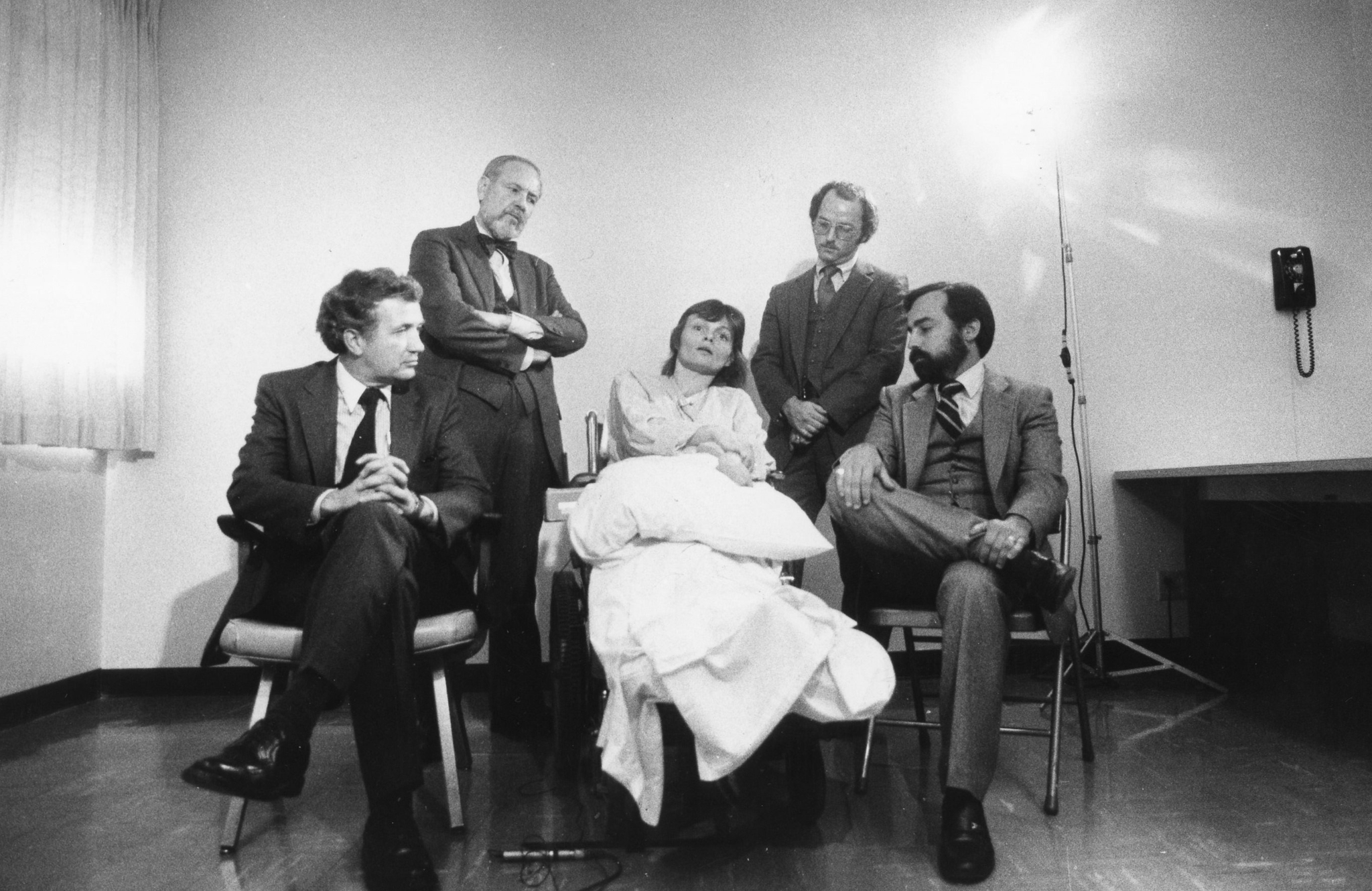

‘Life After’ by Reid Davenport
- Title ‘Life After’ by Reid Davenport
- Author Reid Davenport (director)
- Year 2025
- Language English
- Tags Disability Critiques Expanded Eligibility High Profile Cases Documentary
- Legislative context Penal Code of California, 1872, Art 187 (United States) Bill C-7: An Act to amend the Criminal Code (medical assistance in dying), 2021 (Canada) New York Penal Law section 125.15 (United States) New York Penal Law section 120.30 (United States)
- Author of entry Marc Keller
‘Life After’ opens with footage from 1983 of the 26-year-old Elizabeth Bouvia who lived with cerebral palsy – like director Reid Davenport – and unsuccessfully sought legal permission from the Superior Court of California to starve herself to death with medical assistance at Riverside General Hospital. Her highly publicized quest to die launches the film’s central narrative, as Davenport sets out to discover whether Bouvia was “fighting” or “simply giving up,” and what became of her life after media coverage of it ended in 1997. Davenport interweaves contemporary case studies and legislative developments in the United States and Canada into his telling of Bouvia’s story, illustrating and reflecting on how societies debate and regulate assisted dying for people with disabilities. In so doing, he exposes both the ableist prejudices which inform these debates and legislations, and the systemic barriers to adequate care and support which they do not take into account. In Bouvia’s case, the film argues that the media framed her quest for a legal assisted death as an admirable one by reducing her to her disability, and consistently describing her as “trapped in a useless body.” Davenport, on the other hand, interviews Bouvia’s sisters and uncovers a more complex portrait of a resilient young woman whose will to live only began to fade after she endured many hardships including being discouraged, due to her disability, from graduate school by a professor. The film also highlights the structurally ableist harms Bouvia endured since childhood: painful and futile surgeries rooted in a medicalized view of disability as a deficit to be corrected, and institutionalization. Davenport describes segregation as a highly traumatic experience for disabled people, and notes that ‘institutionalization is segregation’s absolute.’ He extends this argument by exploring a contemporary legal context, where disabled people are eligible for assisted dying. Davenport recounts the story of 39-year-old Canadian Michal Kaliszan, a software developer with spinal muscular atrophy, who is considering a medically assisted death in order to avoid entering an institution for the rest of his life, and thereby surrendering his autonomy. Davenport also presents the story of Jerika Bolen, a 14-year-old from Wisconsin who also lived with spinal muscular atrophy and chose to end her life. Rather than question such a decision, especially given Jerika’s young age, or examine the ways in which she may have felt socially excluded or her pain may not have been adequately managed, Jerika’s community celebrated and supported her decision, throwing her a “prom” in honour of it. To Davenport, while the death of a young person is normally regarded as a tragedy, this event lays bare the deeply ableist assumption that an early death is less grievous than a life with a disability. The film closes by returning to Bouvia, underscoring its central lesson: it is often not disability itself that renders life intolerable, but inadequate support. Bouvia lived until 2014, her life improving through technological advances and better care. In a text read aloud by her sister, Bouvia emphasizes that it was not her disability but her reliance on a bureaucratic system marked by shortcomings and inequities that had driven her original wish to die.
Reid Davenport’s documentary, which won the Special Jury Award at the 2025 Sundance Festival, and was praised by left-leaning and liberal media, is not an anti-assisted dying film. Rather, Davenport makes a case for balancing the privileged, able-bodied viewpoints which have dominated conversations on assisted dying, with a disability perspective. In a North American context, proponents of assisted dying, as well as expanded access to assisted dying, often frame it as a way to end one’s life that is autonomous and freely chosen. Articulating and showcasing the critiques that many disability activists have had of medically assisted dying legislation, ‘Life After’ exposes the risk that granting people with disabilities access to assisted death may lead them to make such choices not out of genuine freedom and autonomy but because of external pressures – such as a lack of welfare support, underfunded and overstretched healthcare systems, and entrenched ableist attitudes, including the assumption that a disabled life inherently lacks quality or the internalized fear of being a “burden” on family and society. Davenport argues, moreover, that in a neoliberal climate, where cost-cutting measures are routinely prioritized, the logic of eugenics are at risk of pushing disabled people toward assisted death. Davenport further counters the point articulated, amongst others, by Dr. Stephanie Green, a Canadian provider and vocal advocate of assisted death and the author of ‘This Is Assisted Dying’ (2022), that while Canadian medical and social systems are “woefully inadequate,” assisted death is a viable alternative to inadequate care, as individuals should not be “held hostage” by a failing system, and should have access to an “out.” ‘Life After’ reflects not only on the American but also largely on the Canadian context, where medical assistance in dying (MAiD) has been available to individuals whose death is not foreseeable since 2021, and where in 2024 the government postponed the expansion MAiD to individuals whose sole condition is psychological to 2027. Primarily, however, the film has been repeatedly discussed in the context of the current and anticipated state of the U.S. healthcare system. Commentators, along with Davenport and producer Colleen Cassingham, have linked its concerns to the Trump administration’s budget bill, which introduced major Medicaid cuts. Since many disabled people already lack adequate public support and live in poverty, these cuts are expected to worsen these individuals’ situations, increasing the risk that disabled individuals may be pushed toward assisted death in jurisdictions where it is legally available.
Suggested citation
-
Life After, Assisted Lab: A Living Archive of Assisted Dying, September 2025 <link>
Reviews
- ‘Life After’ Review: What the End Means, New York Times, 2025 → nytimes.com
- Life After: a nuanced interrogation of right-to-die policy, British Film Institue, 2025 → bfi.org.uk
- Is assisted dying a ‘clear and present danger’ to people with disabilities? New US film asks tough questions, The Guardian, 2025 → theguardian.com
- ‘Life After’ Review: An Empathetic and Confrontational Doc About Disabled People’s Right to Be in Control, Variety, 2025 → variety.com
- ‘We’ll just make our own films’: Disability rights advocates in spotlight at Hot Docs, CityNews Toronto, 2025 → toronto.citynews.ca
Media citations
- Selbstbestimmt bis zuletzt – im Sterben wie im Leben, Wochenzeitung, 2025 → woz.ch
- Is Assisted Suicide About Autonomy or Coercion? A New Film Asks Hard Questions., truthout, 2025 → truthout.org
- Live and Let Die – The Battle Over MAID, CANADALAND, 2025 → canadaland.com
- “Life After”: Film Exposes How Medicaid Cuts, Assisted Dying Laws May Bring Disabled to Early Graves, Democracy Now!, 2025 → democracynow.org
Interest Group citations
- Life After: New film explores life before, during and after the right-to-die movement, Disabled Journalists Association, 2025 → discojourno.com
Related Archival Entries
'All is Beauty/The Most Beautiful Exit' by Simons

La Maison Simons, Broken Heart Love Affair
The advertisement All is Beauty depicts in a positive light the final days of a woman’s life prior to her choosing to receive an assisted death. It was, however, pulled after news reports revealed that the protagonist had been vocal about the lack of support for her illness, and how this influenced her desire for an assisted death.
‘This is Assisted Dying: A Doctor’s Story of Empowering Patients at the End of Life’ by Stefanie…

Stefanie Green, MD
In this memoir, Dr. Stefanie Green chronicles her first year providing medical assistance in dying (MAID) immediately following the procedure’s legalization in 2016. Dr. Green is one of Canada’s leading MAID providers and is the founding president of the Canadian Association of MAID Assessors and Providers.